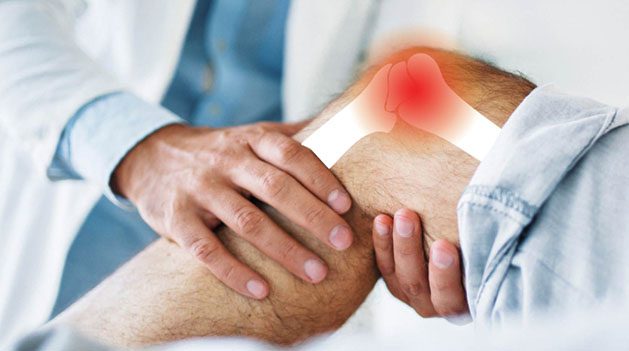More than 120 million people in the US have arthritis. The degenerative effects of arthritis cause wear and tear of the joints. Some common arthritic symptoms are joint pain, stiffness, swelling, warmth, and limited mobility. One of the main types of arthritis is osteoarthritis (OA). With OA, wear and tear damages the cartilage in the joints causing them to lose their smooth gliding action and results in friction or rubbing of the ends of the bones.

When arthritis affects the knees or other areas such as the neck, back, hands, feet, or hips, difficulties arise when trying to get through even the most menial daily tasks. The surrounding muscles may begin to tighten as they try to overcompensate for the pain and protect the injured area. These tight muscles can create tension and limit range of motion. Most people may find that there is little to no relief with over the counter nonsteroidal anti-inflammatory drugs (NSAIDs), like ibuprofen.
Arthritic Knees
Walking, standing, and exercising put a lot of strain on our knees. For example, a person that weighs 150 lbs. walking up a flight of stairs will put approximately 500 lbs. of pressure on their knees with each step. Not only is the knee one of the most intricate of all the joints in the body, but they are also the most susceptible to arthritis. Multiple types of arthritis affect the knees, but osteoarthritis is by far the number one type that surpasses all others.
The articular cartilage is positioned between the three bones of the knee (the femur, tibia, and patella), and provides a smooth gliding surface and acts as a shock absorber. This cartilage is smooth and resilient but susceptible to wear and tear. Once the cartilage begins to break down, it is difficult to stop, and often the cartilage breaks down entirely and wears away. This can cause soreness, swelling, and stiffness, and it is the beginning stages of osteoarthritis, or bone rubbing against bone, which in turn causes bone spurs and a great deal of discomfort.
Osteoarthritis develops slowly, and often the pain becomes worse with time. This type of arthritis is also known as degenerative joint disease because it is commonly associated with the aging process.
But occasionally, this process can also affect younger people as well. The pain can be debilitating and interfere with daily activities, affect your ability to work and create limited range of motion in your life.
Orthopedic Associates of Southwest Florida specialize in the treatment of arthritis, including replacement of the knee, hip, and shoulder, as well as all other orthopedic conditions.
They see many patients that have put off treatment for various reasons, but they want patients to know a few critical details of OA. The articular cartilage has no blood supply; therefore, the cartilage cells are nourished by the synovial fluid and hydrostatic pressure. Once the cartilage is damaged and wears away, there is very little that can be done to regenerate or alleviate the disorder. However, there are multiple ways to slow the progression such as viscosupplementation, corticosteroids, or anti-inflammatory drugs, but the wear and tear will continue despite any efforts to regenerate. A conservative approach is always the first step unless the degeneration is extensive.
There are things patients can do on their own, like losing weight, reducing overexertion, and strengthening the surrounding muscles in the knees, legs, and ankles. The wear and tear can be thought of as wearing away one’s teeth, once they are brittle and deteriorated, a replacement denture or implants are necessary for quality of life. “Conservative surgical options,” such as arthroscopic debridement, cartridge transfer or bio-growth technique have inconsistent and only short term success. We have been attempting arthroscopic bone grafting underneath the worn out joint to try to give better support to the bone. This technique is offered in patients with mild wear and not ready for a joint replacement.
Knee Replacement Surgery
Knee replacement surgery removes the degenerative cartilage and a portion of the underlying bone and replaces them with metal and plastic to restore the smooth surfaces and healthy relationships between the bones. Each joint is sized and fitted precisely to the patient’s anatomy.
There are partial and full replacement surgeries depending on the severity of the arthritis. These devices are very stable and offer long term solutions for mobility and a patient’s lifestyle needs. There is evidence that after 17 years, 97% of total knee replacements are still securely in place, which alleviates the need for any other replacement surgery. After physical therapy, most patients can enjoy their lives on a higher level than before their replacement surgery. Please note partial knee replacements fix only the arthritic surface in one area of the knee and eventually the arthritis will spread to the entire knee requiring a revision to a total knee replacement. Physical therapy assists with improving mobility, range of motion, and restoring normal gait for the patient.
To schedule your appointment, please call Orthopedic Associates of Southwest Florida at 239-768-2272, or ask your physician for
a referral.
Orthopedic Associates of Southwest Florida
239-768-2272 | www.ifixbones.com
Edward R. Dupay, Jr, DO Board Certified
Dr. Dupay graduated from Xavier University in Cincinnati, Ohio. He received his Doctor of Osteopathy at the University of Health Sciences, College of Osteopathic Medicine in Kansas City, Missouri.
Dr. Dupay completed his Internship and Orthopedic Surgery Residency at Flint Osteopathic Hospital in Flint, Michigan. Dr. Dupay has been in the Fort Myers / Cape Coral area since 1987. Dr. Dupay enjoys seeing the “Weekend Warrior” athlete.









